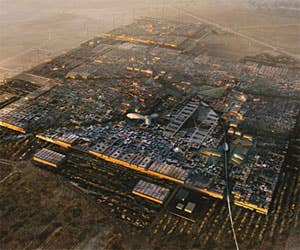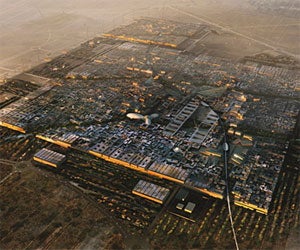Masdar City: A Closer Look at the City of the Future

Share
Modern metropolises are proliferating malignancies of ravenous urban sprawl. Alright, that sentence is definitely laden with a hefty dose of theatrics, but we can at least say that increasingly around the world, people are moving from rural regions into cities yet bureaucracies are unable to manage costs, waste, or carbon footprints let alone healthcare and education. Clearly, something has to be done to turn the tide, and proposals for utilizing the latest technologies to build the “city of the future” from the ground up are abundant. Unfortunately, as Arrested Development fans who remember Bluthton/Sea Britain can attest, ideas are cheap. After all, just about anyone can build a working city in CityVille, but what the world anxiously awaits are for some of these ideas to be hammered into real brick-and-mortar cities as pilot plants for modern urban living. Thankfully, a slew of actual projects are underway, but the greenest of them all promises to be Masdar City…or at least it was when its original design was released in 2006.
Today, things aren’t as rosy and definitely not as green.
Masdar City was initially conceived in the Masdar Initiative, “a global cooperative platform for open engagement in the search for solutions to some of mankind's most pressing issues.” Charged with executing this One Planet Living-inspired plan, the government-owned Abu Dhabi Future Energy Company, now known as Masdar, set out to create a “world-class research and development hub for new energy technologies” through the creation of a clean energy cluster 17 kilometers outside of Abu Dhabi. Central to the Masdar Initiative was the creation of a carbon-neutral urban center powered by renewable energy that could sustain a population of 40,000 and support approximately 1,500 businesses and 50,000 commuters.
In effect, Masdar City was seen as part of a larger plan to increase Abu Dhabi’s economic diversity by drawing collaborative-minded companies around the world into this technological oasis. As a sandbox city, companies would have the green light to test and demonstrate commercial-scale technologies while drawing on the expertise of investigators at the Masdar Institute of Science and Technology, a post-graduate university established in partnership with MIT. The opportunities for commercialization of technologies would follow suit, vaulting Abu Dhabi into a lead global technology producer. This vision of being the birthplace of advanced technologies is encapsulated in its very name, Masdar, which means “the source” in Arabic.
With an initial price tag of $24 billion, the Initiative had some pretty bold goals and its first, and clearly the most telling, was power. The United Arab Emirates (UAE) has the sixth largest oil reserves in the world and the fifth largest reserves of natural gas, so its aggressive pursuit of advanced energy technologies, including solar, geothermal and waste-to-energy, while seeking to maximize efficiency sends a clear message: Masdar City will thrive in a post-petroleum world. Achieving this efficiency would be possible through a combination of efforts in energy technologies and construction. A city wall would provide a barrier to the desert heat while narrow gaps between buildings and a wind tower would collectively make the street-level temperature quite comfortable for pedestrians.
Another major goal, as mentioned in a previous article, was a multi-tiered transportation effort squarely aimed at eliminating the use of fossil fuel-burning vehicles. A trackless, electric podcar system would serve as driverless taxis, ferrying up to four passengers to nearly 100 stations through a concrete maze underneath the city while a metro line and high-speed rail would handle commuters from Abu Dhabi and connect to the airport. The podcar system also exemplifies Masdar City’s commitment to being a testing ground of new technologies as are efforts to power street lights with LEDs and water fountains that concentrate water from the air.
But the question is, what has become of these ambitious plans for the city of the future since construction at the six-square kilometer site began in 2008?
Be Part of the Future
Sign up to receive top stories about groundbreaking technologies and visionary thinkers from SingularityHub.


Well, to no one’s surprise, progress was slowed by the financial crisis. As of today, the city consists of six buildings, a few businesses, and a few hundred students. In an effort to cut development costs down to $18 billion, the platform necessitated by the podcar system that would raise the city 7.5 meters was abandoned, and with it, the podcars except for the concept line. Alternative mass transportation is under consideration but the dream of a gasoline-free zone may be over. Additionally, a solar power system that would generate energy from panels on every building’s rooftops has also been scrapped in favor of the solar panel array already being successfully used to power the Institute. And yet, these challenges are opening doors to other approaches, such as the use of newly discovered subterranean water reserves for cooling, even as the completion date for the first phase is pushed back to 2015.
Criticisms of Masdar City’s technological overkill and isolationism underscore that no one in the world knows how to go about constructing a functional sustainable city within a realistic budget and timeframe. Fortunately, UAE is at least making an attempt with Masdar City and letting the world in on what they are discovering. Even Secretary of State Hillary Clinton, in a speech given after a tour of the Institute, stated, “I want the world to know that the US is partnering with you because we are betting on Abu Dhabi and the UAE. We are betting that this incredible investment represented by Masdar is going to pay off, and when it pays off it will not only mean a better life for the people of this country and this region, it will have ripple effects throughout the world.”
Efforts like Masdar City are vital. Ultimately, it is research on a grand scale with opportunities to learn as much from failure as from success. And perhaps the lesson here is a simple, yet sobering one: the future of urban development is not about big budget innovation, but smaller steps through entrepreneurial progress and adaptability. Let’s face it, cities from scratch can be living laboratories for civil engineering and green technology, but the majority of the world lacks the funds to build cities from nothing. What’s needed are ways to retrofit and upgrade the world’s cities and hopefully, some of the solutions can emerge through the course of this project.
So keep an eye on Masdar City as its story unfolds. Though it's likely not "the city of the future," it may be the city that gets us there faster than any other.
[Image credit: Businessweek]
[Sources: Masdar.ae, Time, New York Times, 2daydubai, The National]
David started writing for Singularity Hub in 2011 and served as editor-in-chief of the site from 2014 to 2017 and SU vice president of faculty, content, and curriculum from 2017 to 2019. His interests cover digital education, publishing, and media, but he'll always be a chemist at heart.
Related Articles

Data Centers in Space: Will 2027 Really Be the Year AI Goes to Orbit?

How Scientists Are Growing Computers From Human Brain Cells—and Why They Want to Keep Doing It

Scientists Say We Need a Circular Space Economy to Avoid Trashing Orbit
What we’re reading
